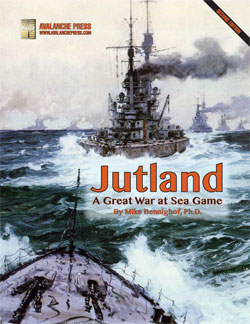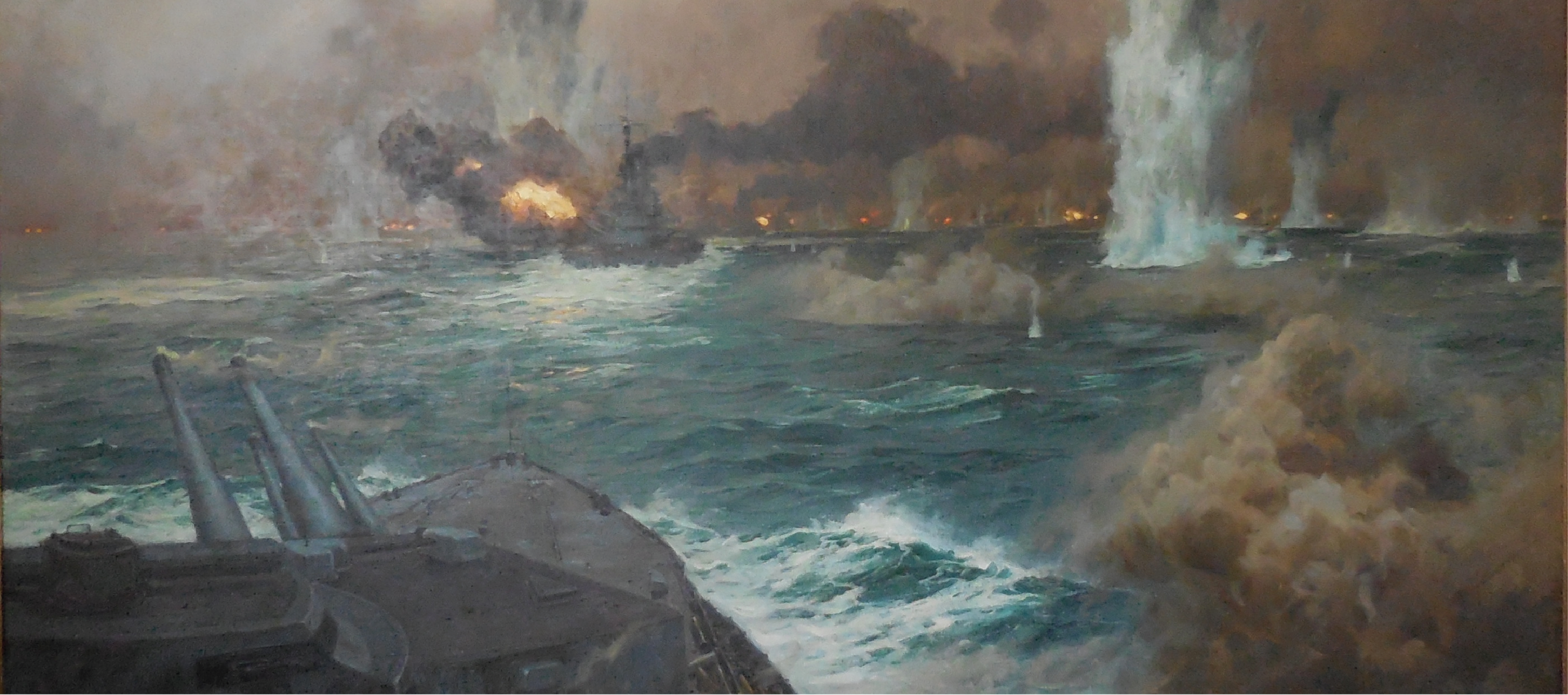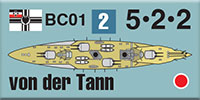| Jutland:
The Battle, Part Five:
The Dreadnoughts Engage
By Mike Bennighof, Ph.D.
June 2024
 Once Sir John Jellicoe had re-aligned his fleet into battle formation across the path of the oncoming High Seas Fleet, Reinhard Scheer’s German battleships faced a severe disadvantage. In theory, they could only reply with their forward batteries, but poor visibility thanks to smoke, haze and the rapidly-setting sun made it impossible for them to acquire targets in any event. The British had their own difficulties; Sir David Beatty led his battle cruisers across their line of sight to the Germans, masking the fire of the leading squadrons, and many of the ships had to cease fire for stretches when they couldn’t make out the enemy regardless of Beatty’s gaffe. Once Sir John Jellicoe had re-aligned his fleet into battle formation across the path of the oncoming High Seas Fleet, Reinhard Scheer’s German battleships faced a severe disadvantage. In theory, they could only reply with their forward batteries, but poor visibility thanks to smoke, haze and the rapidly-setting sun made it impossible for them to acquire targets in any event. The British had their own difficulties; Sir David Beatty led his battle cruisers across their line of sight to the Germans, masking the fire of the leading squadrons, and many of the ships had to cease fire for stretches when they couldn’t make out the enemy regardless of Beatty’s gaffe.
The leading German battleship, König, had already been hit once, and now quickly took seven more hits, most of them from the British flagship Iron Duke. Most of the British battleships sighted none of their German counterparts, instead unleashing their fury on the hapless light cruiser Wiesbaden, drifting helplessly between the opposing fleets.
Despite the British inability to employ all of their enormous firepower advantage, Reinhard Scheer’s High Seas Fleet faced a desperate situation. The heavy smoke made by his own ships drifted towards the British battle line, obscuring the Germans’ targets, while their own ships were silhouetted against the setting sun. At 1936, two minutes after the last of the British battleships had opened fire, Scheer ordered the Gefechtskehrtwendung, the “battle turn-away maneuver,” to starboard.
The tactic, dutifully practiced during every annual peacetime maneuvers, had each ship simultaneously turning on its own axis, instead of following the ship ahead of it to turn one by one. The fleet executed it promptly and precisely, putting the British battleline behind them. As the fleet turned, the cruiser Rostock signaled Ran an der Feind to her two flotillas of torpedo boats, but most could not penetrate the British screen of light ships to deliver their torpedoes against the British battleships – one torpedo struck the dreadnought Marlborough, causing some flooding. Another torpedo, probably from the cruiser Wiesbaden, struck the new dreadnought Revenge directly outboard of her forward magazines, but failed to detonate.
Now Jellicoe hesitated; the British were well aware of the Gefechtskehrtwendung and in an October 1914 memo Jellicoe had informed the Admiralty that should he encounter it in battle he would not pursue – it seemed obvious to him that the most effective wartime addition to the tactic would be to toss mines off the stern of each retreating ship. Or, somewhat less likely, to draw the pursuers over a line of waiting submarines.

The German dreadnoughts under fire in Claus Bergen’s painting.
But the battle was not over. Reinhard Scheer would not leave men in the water. The High Seas Fleet commander had no intention of escaping, because so far, his fleet was winning the battle
The stricken cruiser Wiesbaden continued to helplessly drift between the battle fleets, and Scheer ordered his fleet to turn to the west and loop back around to attack the rear of the British battle line. That would allow the rescue of survivors from Wiesbaden; torpedo boats had already tried to reach the cruiser but had been driven off by British fire. No salvation would come for Wiesbaden, and all but one of her crew would die at Jutland, including the well-known nautical writer Gorch Fock.
Scheer had another problem as well. Night had not fully fallen, and in a stern chase, his slow pre-dreadnoughts as well as the eight early dreadnoughts of the Nassau and Oldenburg classes would not be able to escape the Grand Fleet. Scheer had no way to know that Jellicoe would not pursue as a matter of policy.
By 1945, the British had lost sight of the Germans. Jellicoe believed that Scheer would take the prudent course, and return to his bases. The Germans had sunk three enemy battlecruisers and a pair of armored cruisers, against no capital ship losses of their own (though unknown to Jellicoe, the battle cruiser Lützow had already broken formation in an attempt to reach home before progressive flooding sank her). The British commander directed his fleet to the south-east, in an attempt to cut off the Germans from reaching their bases.
At 1955, Scheer’s flagship Friedrich der Grosse signaled another Gefechtskehrtwendung to starboard, taking the High Seas Fleet back at the British. While Jellicoe believed the Germans to be farther to the south-east and bearing in that direction, Scheer knew almost exactly where his enemy lay and hoped to attack the center of the British line.
With Lützow limping away, assisted by four torpedo boats pumping out a concealing smokescreen, Derfflinger now led the German line. Her port-side torpedo netting – a lattice of heavy metal wire held outboard of the hull by metal arms, and in practice useless against torpedoes anyway – had been shot up and threatened to break loose and foul the ship’s propellors. If that happened, the Iron Dog would be struck dead in the water in the presence of two dozen British battleships. At 2005 her captain, Johannes Hartog, ordered a stop while seamen swarmed over the damaged netting with axes and bolt-cutters. Within two minutes they had dragged the netting onto the deck and secured in there, but for two minutes the High Seas Fleet had drifted to a halt in the midst of history’s largest surface battle.
Agincourt spotted Derfflinger at 2006 and opened fire, but it took some minutes for the High Seas Fleet to hove into view for the other British dreadnoughts, several of which were already firing at German torpedo boats. Jellicoe and turned his fleet out of their single line-ahead formation and they had started to resume their column formation, which meant that the columns on Jellicoe’s left had their fire masked by the other British ships.

The British dreadnoughts open fire in W.L. Wyllie’s painting.
But those with a clear firing solution had targets at nearly point-blank range. During the next thirty minutes the German heavy ships suffered a total of 38 heavy-caliber shell hits, fourteen of those against Derfflinger. The Iron Dog shook off most of those like water, but a 15-inch shell from Revenge destroyed D turret, killing 75 men, and another wrecked C turret, with 68 more dead. So many near-misses fell near the ship that dead fish coated the sea around her.
The Germans could not make out targets, and their ineffective fire did little damage beyond a hit on Colossus by Seydlitz. The German battle cruisers, now leading the German battle line, had been slowed by their battle damage, and this in turn both slowed the German ships in line behind them and caused them to clump together. Several battleships narrowly avoided ramming other German ships.
Scheer took immediate action. At 2013 he ordered the remaining battlecruisers, then drawing away from the Grand Fleet, to engage the British more closely: Schlachtkreuzer ran an den Feind, voll einsetzen! Two minutes later, he ordered his torpedo boats to attack the British battleships and lay a smokescreen. Three minutes after that, the High Seas Fleet executed yet another Gefechtskehrtwendung.
This time, the maneuver went far less crisply and precisely than the first two. Several ships had sheered out of formation following Derfflinger’s brief halt, and only narrowly avoided collisions. On his own initiative, Capt. Franz Brüninghaus of König took his ship between the German line and the British to lay down a smokescreen – gas poisoning from the heavy smoke laid by his ship would end his career at sea. British fire diminished as the Germans pulled away and Jellicoe failed to order a pursuit.
Sunset came at 2105, with full darkness by 2130. The Germans had broken contact cleanly, but only had one route back to their bases. Jellicoe, out-fought by Scheer’s smaller fleet so far, still had the opportunity for a decisive night action.
The story continues in Part Six.
Order Jutland second edition here.
The Jutland Experience
 Jutland Second Edition (full game) Jutland Second Edition (full game)
Jutland: North Sea 1914
Jutland: Dogger Bank
Journal No. 46: Iron Dogs
Retail Price: $179.96
Package Price: $150.00
Gold Club Price: $120.00
You can order the Jutland Experience right here.
Sign up for our newsletter right here. Your info will never be sold or transferred; we'll just use it to update you on new games and new offers.
Mike Bennighof is president of Avalanche Press and holds a doctorate in history from Emory University. A Fulbright Scholar and NASA Journalist in Space finalist, he has published a great many books, games and articles on historical subjects; people are saying that some of them are actually good.
He lives in Birmingham, Alabama with his wife, three children, and his new puppy. His Iron Dog, Leopold, could swim very well.
Want to keep Daily Content free of third-party ads? You can send us some love (and cash) through this link right here.
|
